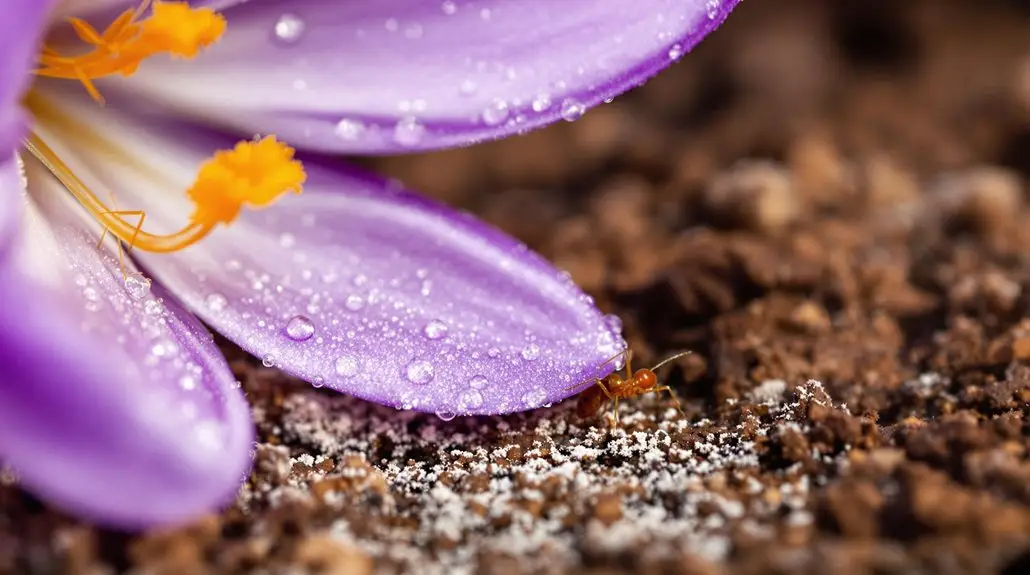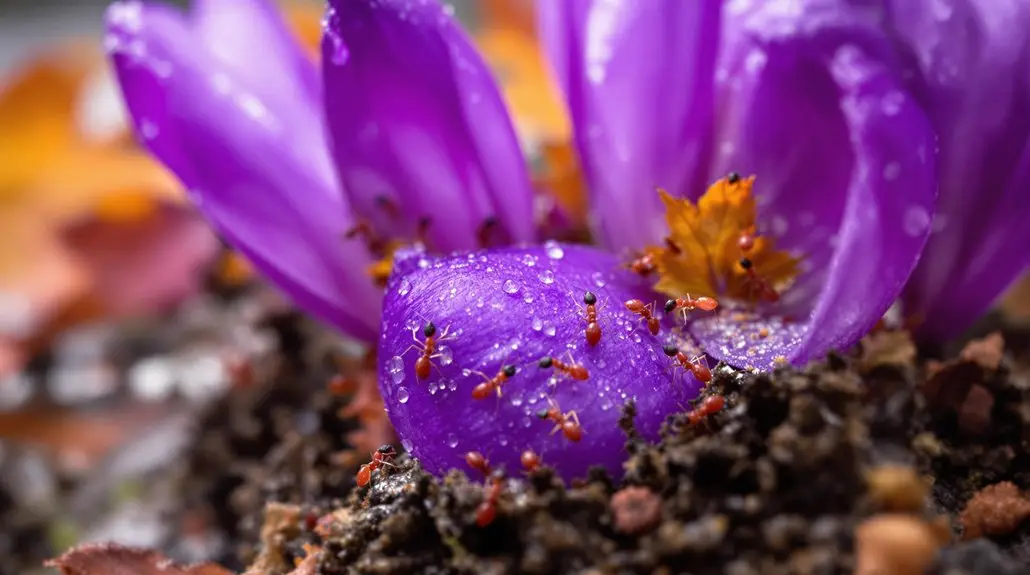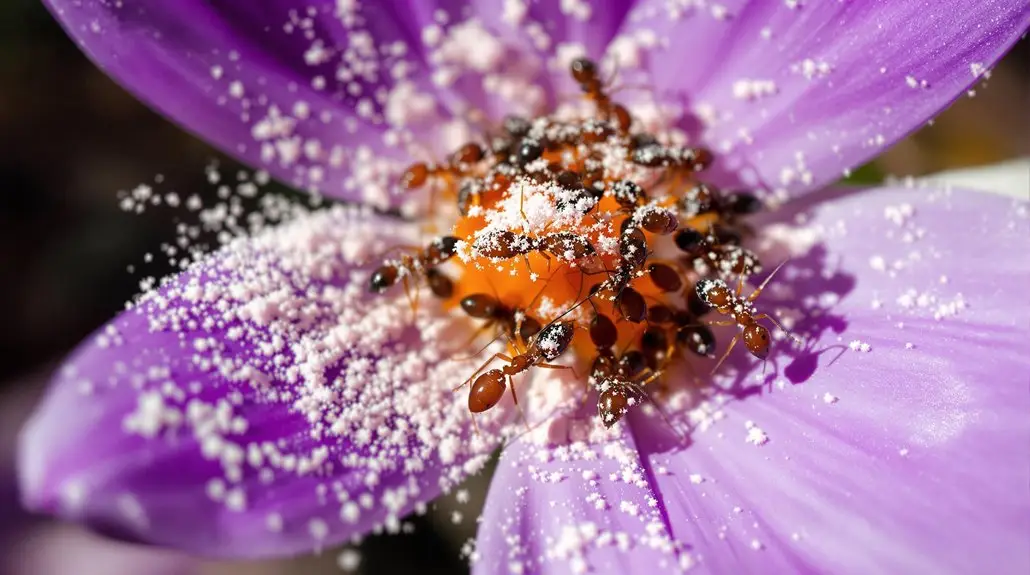Autumn crocus bulb powder, which contains colchicine, greatly affects red imported fire ants‘ survival and behavior. Research shows that exposure leads to increased mortality rates, with higher concentrations causing more severe effects. Sublethal doses alter foraging patterns and disrupt communication among ants, which can compromise colony productivity and health. Additionally, these changes can influence long-term dynamics within ant colonies. Understanding these impacts is essential for developing effective pest management strategies and exploring new approaches to biocontrol.
Key Insights
- Autumn Crocus contains colchicine, which disrupts cell division and is toxic to red imported fire ants, affecting their survival and behavior.
- Exposure to bulb powder results in significantly reduced survival rates, with higher concentrations leading to greater mortality among fire ants.
- Sublethal doses of colchicine alter fire ant behavior, causing disorientation, reduced foraging efficiency, and increased aggression within colonies.
- Behavioral changes in exposed ants can impact colony dynamics, food acquisition, and overall productivity, threatening long-term colony health.
- Future research should assess the ecological implications of colchicine use in pest management while ensuring the protection of beneficial insect species.
Overview of Autumn Crocus and Its Alkaloids

Although many people admire the beauty of the Autumn Crocus, it’s essential to recognize that this plant contains potent alkaloids, which can have significant biological effects. The primary alkaloid, colchicine, is known for its ability to disrupt cellular processes, particularly during cell division. This compound can be toxic to various organisms, including insects.
When exposed to bulb powder derived from the Autumn Crocus, fire ants may experience sublethal effects, which can alter their behavior and survival rates. Research indicates that these alkaloids affect the nervous system and may inhibit reproduction, leading to a decline in colony health.
Understanding the toxicity of the Autumn Crocus is vital, not only for ecological balance but also for effective pest management strategies. By recognizing the potential risks associated with this beautiful plant, you can appreciate its role in the environment while being mindful of its effects on local wildlife.
The Ecology of Red Imported Fire Ants
When studying red imported fire ants, you’ll find that their habitat preferences markedly influence their behavior and survival.
These ants thrive in warm, open environments, such as lawns, pastures, and disturbed areas, where they can easily establish their colonies.
Additionally, their foraging behavior patterns reveal a strong tendency to seek out food sources efficiently, which is essential for their colony’s growth and sustainability.
Habitat Preferences
Red imported fire ants (Solenopsis invicta) exhibit specific habitat preferences that greatly influence their distribution and population dynamics across various environments.
These ants thrive in warm, moist climates, often favoring open, sunny areas with loose, well-drained soils. You’ll find them commonly in disturbed habitats, such as agricultural fields, urban areas, and roadsides, where competition is lower, allowing their colonies to establish and expand rapidly.
They prefer habitats that provide ample food sources and shelter, enabling them to build elaborate nests. Notably, their adaptability allows them to survive in diverse settings, from grasslands to forests, showcasing their resilience.
Understanding these preferences is essential for managing their populations and mitigating their ecological impacts effectively.
Foraging Behavior Patterns
Foraging behavior patterns of red imported fire ants reflect their adaptability and efficiency in locating food sources within their preferred habitats.
These ants exhibit organized foraging strategies, often forming trails that lead other members of the colony to food. They utilize pheromones to communicate and reinforce these trails, ensuring a coordinated effort in gathering resources.
Additionally, red imported fire ants are opportunistic feeders, capable of adjusting their foraging habits based on food availability and environmental conditions. They can forage both individually and in groups, allowing them to exploit a variety of food sources, from proteins to sugars.
This versatility in foraging not only supports their survival but also enhances their competitive edge against other species in their ecosystem.
Experimental Design and Methodology

In this section, you’ll learn about the experimental setup used to assess the toxicity of autumn crocus bulb powder on fire ants, including the specifics of how treatments were applied.
We’ll also outline the data collection techniques that researchers employed to guarantee accurate and reliable results.
Experimental Setup Details
To investigate the toxicity of Autumn Crocus bulb powder on fire ants, researchers designed a controlled experiment that involved several key components to guarantee accurate and reliable results.
First, they established distinct groups of fire ants, ensuring that each group was similar in size and health.
Next, they prepared various concentrations of bulb powder to assess its effects on the ants over time.
The experiment took place in a temperature-regulated environment, which minimized external variables that could influence the outcomes.
Researchers utilized standardized observation methods to record the ants’ behavioral and physiological responses, aiming to assess not only mortality rates but also sublethal effects.
This meticulous setup allowed for a thorough understanding of the bulb powder’s impact on these insects.
Treatment Application Procedures
While conducting the experiment, researchers meticulously applied the Autumn Crocus bulb powder to the designated groups of fire ants using a precise methodology that guaranteed consistency across all trials.
They divided the fire ants into control and treatment groups to evaluate the toxicity and sublethal effects effectively. Each group received a specific dosage of the bulb powder, ensuring that the application was uniform across all samples.
Researchers utilized a calibrated dispensing tool to achieve accurate measurements, which minimized variability in treatment exposure. After application, they monitored the ants closely, recording any immediate reactions and behavior changes.
This careful approach not only enhanced the reliability of the results but also provided a clear foundation for understanding the bulb powder’s effects on the fire ant population.
Data Collection Techniques
Following the application of the Autumn Crocus bulb powder, researchers implemented a structured experimental design to ascertain robust data collection that would accurately reflect the effects of the treatment on fire ants. They employed a randomized control trial to guarantee unbiased results, with specific focus on mortality rates and behavioral changes. The data collection methods included direct observation and recorded counts of affected ants in controlled environments.
| Measurement Type | Description |
|---|---|
| Mortality Rate | Percentage of dead ants post-treatment |
| Behavioral Changes | Notable shifts in foraging behavior |
| Recovery Time | Time taken for ants to return to normal activity |
| Colony Impact | Changes in colony dynamics observed |
| Statistical Analysis | Tests used for data interpretation |
This systematic approach helped ascertain that findings were both reliable and valid.
Effects of Bulb Powder on Ant Survival

The application of Autumn crocus bulb powder has been studied to determine its effects on the survival rates of fire ants, revealing notable insights into the potential use of this substance as a pest management tool.
Research indicates that exposure to this bulb powder can lead to detrimental effects on ant populations. Key findings include:
- Reduced Survival Rates: Fire ants exposed to bulb powder exhibit markedly lower survival rates compared to those not exposed.
- Dose-Dependent Effects: The severity of the impact correlates with the concentration of bulb powder; higher concentrations result in greater mortality.
- Long-Term Implications: Even sublethal doses can affect colony dynamics, potentially leading to decreased reproductive success and colony viability.
These results suggest that Autumn crocus bulb powder could be an effective natural pesticide, offering an environmentally friendly alternative to traditional chemical treatments for managing fire ant populations.
Understanding these effects can help inform pest management strategies in your community.
Behavioral Changes Induced by Colchicum Exposure
Exposure to colchicum, a toxic component found in Autumn crocus bulbs, has been shown to induce significant behavioral changes in fire ants, which can affect their foraging, communication, and overall colony dynamics.
When fire ants come into contact with colchicum, you might notice alterations in their foraging patterns; they may exhibit reduced activity or become disoriented, ultimately impacting the colony’s food acquisition.
Communication within the colony, vital for coordinating tasks, can also be disrupted, as the ants may fail to respond to pheromonal signals effectively.
Additionally, these behavioral shifts can lead to increased aggression among workers, creating conflict over resources.
Such changes not only influence individual ants but can ripple through the entire colony, affecting overall productivity and survival.
Understanding these behavioral alterations is essential for comprehending the broader implications of colchicum exposure on fire ant populations and their ecological roles.
Implications for Biocontrol Strategies

While investigating the potential for using colchicum derived from Autumn crocus bulbs in biocontrol strategies, researchers have started to recognize both the benefits and challenges associated with this approach.
Utilizing this natural compound could offer a new pathway in managing invasive species like the red imported fire ant, but it’s essential to evaluate several factors:
- Target Specificity: Ensuring that colchicum effectively targets fire ants without harming beneficial insects is vital for maintaining ecological balance.
- Environmental Impact: Researchers must assess how colchicum affects local ecosystems, as unintended consequences could arise from its application.
- Regulatory Considerations: Maneuvering legal frameworks surrounding the use of plant-derived substances in pest control is necessary for successful implementation.
Frequently Asked Questions
Are There Any Safe Uses for Autumn Crocus in Gardens?
While autumn crocus adds beauty to gardens with its vibrant flowers, it’s essential to recognize that its bulbs are toxic if ingested.
However, you can enjoy its ornamental value by planting it in areas inaccessible to pets and children.
Additionally, the plant attracts various beneficial insects, contributing to the ecosystem.
Always guarantee you’re aware of the potential risks associated with toxic plants, making informed decisions about their placement in your garden.
How Does Colchicum Affect Other Insect Species?
You might be surprised to learn that colchicum can greatly impact various insect species.
Research shows that colchicum’s alkaloids disrupt the nervous systems of insects, leading to paralysis or even death. While some insects may exhibit resistance, others, like certain pollinators, are highly susceptible to its effects.
Can Colchicum Be Harmful to Pets or Livestock?
Colchicum can indeed be harmful to pets and livestock.
If ingested, the plant contains colchicine, a compound that can lead to severe gastrointestinal distress, respiratory issues, and even death in animals.
You should always keep colchicum plants away from your pets and livestock to prevent accidental ingestion.
If you suspect your animal has consumed any part of the plant, it’s vital to consult a veterinarian immediately for proper care and treatment.
What Are the Regulatory Concerns Surrounding Colchicum Use?
Steering through the regulatory landscape surrounding colchicum use resembles traversing a minefield, where caution is paramount.
Authorities impose strict guidelines due to its potent alkaloids, which can pose risks to human health and the environment.
These regulations often require extensive labeling, restricted access, and thorough research to guarantee safety.
Consequently, you’ll find that many jurisdictions mandate clear documentation of colchicum’s potential effects, reflecting a commitment to responsible management of this complex plant.
How Can I Identify Autumn Crocus in My Area?
To identify autumn crocus in your area, look for its distinct, broad, lance-shaped leaves that typically emerge in late summer.
You’ll notice the flowers bloom in fall, displaying large, purple or white petals that can resemble those of crocuses.
Pay attention to its growth in well-drained soil, often in gardens or naturalized settings.
If you find clusters of these plants, you might’ve successfully identified autumn crocus in your surroundings.
Final Thoughts
The Power of Nature: A Sustainable Solution to Ant Invasion
To summarize, the findings from this study illustrate that the bulb powder of autumn crocus (Colchicum autumnale) greatly impacts red imported fire ants (Solenopsis invicta) by reducing their survival rates and inducing notable behavioral changes. As researchers explore the potential of using this plant’s alkaloids as a biocontrol agent, it becomes clear that harnessing natural substances can provide effective, environmentally friendly alternatives to conventional pest management methods, offering a promising pathway to balance ecosystems while mitigating ant populations.
A Call to Action for South Florida Residents
If you’re struggling with red imported fire ants in South Florida, consider the innovative solutions offered by NaturePest Holistic Pest Control. Embrace the power of nature and explore how our natural pest control methods can help you manage ant populations while protecting the environment. Join us in creating a healthier ecosystem today!

